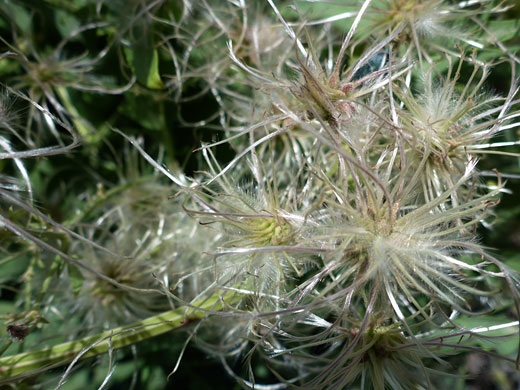Clematis Orientalis, Oriental Virginsbower
Plants > Wildflowers > Ranunculaceae > Clematis Orientalis
Common name:
Oriental virginsbower
Family:
Scientific name:
Clematis orientalis
Main flower color:
Range:
Scattered areas in states between New Mexico and Washington (non native)
Height:
Stems are climbing or creeping, up to 2 feet long
Habitat:
Waste ground, roadsides, open woodland, up to 8,500 feet
Leaves:
Pinnately divided into 5 to 7 ovate to lanceolate leaflets, lobed or toothed; leaflets up to 2 inches long
Season:
June to September
Clematis orientalis, native to Asia and Europe, has become established in scattered areas across the western states. Plants are woody vines, creeping or climbing, and generally inhabit waste or disturbed ground.
Leaves are divided into lance-shaped leaflets, which usually have one or two lobes towards the base, and are lined with a few smaller lobes, or teeth. Upper leaf surfaces usually have a covering of very short hairs.
Flowers are produced in small clusters (three or more) from the leaf nodes, and are attached by slender stalks of up to 4 inches. Flowers are formed of four broad, recurved yellow sepals, relatively short-lasting, a central cluster of between 20 and 40 stamens, which are hairy towards the tip, and up to 150 longer pistils. The pistils are feathery along their whole length, and angled in all directions.
Leaves are divided into lance-shaped leaflets, which usually have one or two lobes towards the base, and are lined with a few smaller lobes, or teeth. Upper leaf surfaces usually have a covering of very short hairs.
Flowers are produced in small clusters (three or more) from the leaf nodes, and are attached by slender stalks of up to 4 inches. Flowers are formed of four broad, recurved yellow sepals, relatively short-lasting, a central cluster of between 20 and 40 stamens, which are hairy towards the tip, and up to 150 longer pistils. The pistils are feathery along their whole length, and angled in all directions.
All Contents © Copyright The American Southwest | Comments and Questions | Contribute | Site Map



